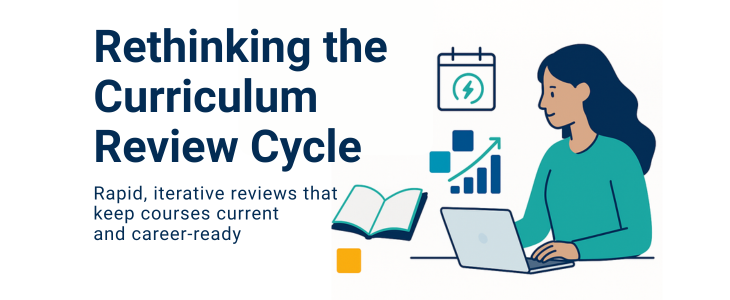Rethinking the Curriculum Review Cycle: Why Faster, Iterative Reviews Matter

When your curriculum is updated less often than the tools students use, learning falls behind. In today’s world—where AI, policy changes, and new industry practices arrive quickly—three-to-five-year reviews simply don’t cut it. This post makes the case for rapid, iterative curriculum review cycles (annual or semesterly checkpoints), and shows how modular content, clear workflows, and strong instructional design support let institutions move faster without sacrificing quality.
Why the traditional curriculum review cycle is showing its age
Static cycles miss real-time change
Most institutions still run three-to-five-year review schedules. After approval, courses often live unchanged for years. In that time:
- New tools and platforms become standard in industry (for example, AI-assisted workflows and cloud-based analytics).
- Regulations and ethical frameworks evolve.
- The examples and case studies students rely upon grow stale.
When curricula lag, students learn outdated practices. That harms outcomes and institutional reputation.
The burden and the illusion of thoroughness
Long cycles were designed to ensure quality through deep, committee-led scrutiny. But they also create long lead times, lots of paperwork, and a tendency to bundle many changes into expensive, infrequent overhauls. The result: big, disruptive redesigns rather than continual alignment.
The opportunity cost
Every semester that passes without targeted updates is a missed chance to improve clarity, reduce friction, and make courses more inclusive and applicable. Rapid review cycles reduce that opportunity cost by enabling smaller, focused edits more often.
Read: Maximizing Impact: Independent Publishing for Educators
What a rapid curriculum review cycle looks like (practical and doable)
Core idea: targeted checkpoints, not full redesigns
A rapid cycle breaks the monolithic review into frequent, lightweight inspections that focus on what matters now:
- Content relevance: Are readings and examples current? Do the problem sets reflect new methods?
- Student outcomes: Are students meeting learning objectives? Where are they struggling?
- Instructional design: Would modularization, microlearning, or interactive media reduce friction?
These checks happen annually or each semester and emphasize incremental improvement. They are easier to staff and less emotionally taxing than big redesigns.
The return on investment: three big wins
1. Faster response to change
When a law, discovery, or industry practice shifts, you can update the relevant module immediately — not three years later. That agility preserves curriculum credibility.
2. Improved student satisfaction and outcomes
Students notice when a course feels contemporary. Rapid updates demonstrate that the institution values relevance, which boosts engagement and retention.
3. Greater faculty agility — without burnout
Frequent small edits are less stressful than massive redesigns. With strong instructional design support, faculty keep control of academic content while technical and design teams handle delivery, accessibility, and assessment refinement.
Making rapid reviews practical: the technology and process that enable them
To move from theory to practice you need two ingredients: process discipline and the right platform. Here’s what to look for.
Modular content architecture
Break courses into reusable parts — chapters, case studies, datasets, assessments, multimedia assets. Modular content lets you:
- Update a single chapter without reworking the entire course.
- Reuse vetted content across multiple offerings.
- Create multiple course variants quickly for different audiences.
LiveCarta in practice: rapid review — a day in the life
At LiveCarta we designed our platform to support rapid, iterative review cycles. Here’s how that looks in practice.
Collections instead of static files
Users create Collections: live, editable compilations of chapters from the Catalog, media, and assessments. Want to swap a reading? Include a new chapter from your library or from the LiveCarta catalog. Update a dataset? Upload a revised file and publish it instantly.
Custom Copy and targeted edits
Faculty can create a Custom Copy from a catalog text, tailor it for their course, and publish that version to students. Across terms, they can toggle chapters on or off, add current research, or adjust assessments with no reauthoring required.
Collaborative review workflow
Assign co-creators to chapters, set editing rights, and track revisions with built-in version control. Instructional designers and faculty work in parallel, not sequentially, accelerating review while keeping quality checks intact.
Seamless distribution and mid-course updates
Hit “Publish” and students see the latest version immediately — no printing, no LMS reconfiguration. Need to respond to a breaking development? Push a mid-course update and students get the corrected or additional material without delay.
Quick checklist: start your first rapid review cycle this term
Use this step-by-step checklist to begin without overwhelming your team.
- Pick a realistic cadence — semesterly or annually. Start small.
- Define quick review templates — 1-page prompts on content relevance, assessment health, and accessibility.
- Assign roles — who checks content, who reviews learning analytics, who publishes updates.
- Prioritize using data — focus first on modules with the most student friction or the oldest content.
- Use modular content — swap, not rebuild.
- Document and iterate — track changes and outcomes to fine-tune the process.
Real-world example: an instructor who turned revising into a rhythm
One professor used LiveCarta’s Custom Copy feature to adapt a catalog text for a course. Instead of rebuilding each semester, he:
- Turned certain chapters off for term one and highlighted others.
- Added links to the latest research and case studies mid-term.
- In the next semester, toggled chapters back on and adjusted assessment emphasis based on students’ performance data.
That incremental approach saved time, kept the course relevant, and made continuous improvement a manageable habit.
Conclusion
Speed and quality aren’t opposites — make speed repeatable and responsible by using modular content, lean review templates, and strong instructional design support. Start with one module this term, measure outcomes, and scale what works.
Ready to move from occasional overhauls to continuous improvement? Request a demo and we’ll show how LiveCarta’s Collections, Remix-on-Demand, and AI-powered tools can keep your courses current and audit-ready.
